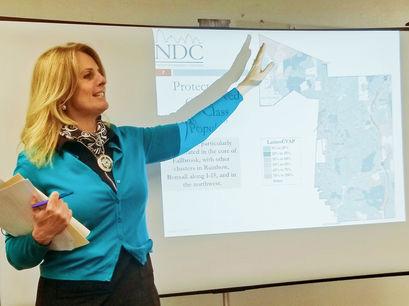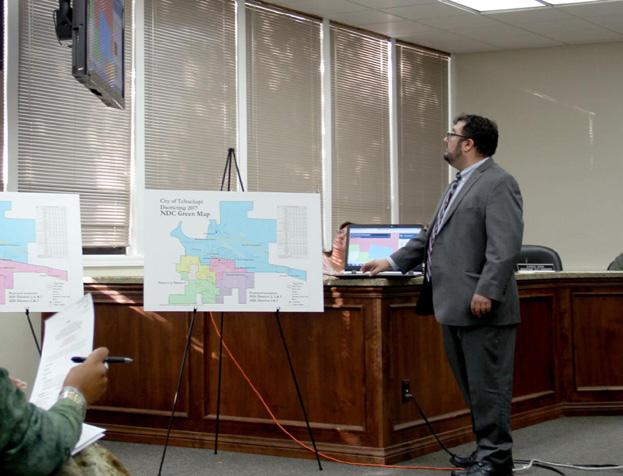
3 minute read
SPONSOR HIGHLIGHT: NDC
JESSICA BLAIR, MMC, 1ST VICE PRESIDENT

City Clerks are NDC’s vital partners throughout our 40 years-and-counting of demographic studies and districting and redistricting projects for California local governments. When an at-large election city wants a demographic study to assess potential liability under the Federal or California Voting Rights Acts, or when Council election districts need drawing or redrawing, NDC is there to help. We appreciate the vital direction and support City Clerks provide in every one of those projects. This year it is again our pleasure to sponsor CCAC and to join you at your conferences and meetings.
Transitions to district elections can be difficult. While districts offer the benefit of more locally-focused elections and reduce the cost to run for Council, district elections also mean individual voters only vote in Council elections every four years instead of every two, and only vote for one Councilmember instead of for the whole Council. After districting, explaining these impacts to often-surprised voters usually falls on the City Clerk. But NDC can help. Before passage of the California Voting Rights Act (CVRA) in 2002, only 29 of California’s 482 incorporated cities and towns held by-district elections for City Council. But the slow flow of cities moving to bydistrict elections from 2002 to 2015 turned into a flood following Sacramento’s 2015 adoption of AB350. NDC’s most recent count found CVRA prompted 185 cities to move to by-district elections, increasing the total number of by-district election cities from 29 to 214.
Santa Clarita and Irvine recently agreed to change to by-district elections, meaning every California city with a Census count of 200,000 residents or more will hold by-district Council elections. Among cities with 150,000 to 200,000 residents, only four of the 16 cities remain at-large. Among cities with 105,000 to 150,000 residents, only two of those 31 cities are still at-large while a third is “from district” (where Councilmembers must live in a given district, but the election is still held citywide).
District elections are now found in cities of all sizes: before CVRA, only ten of the 407 cities currently under 100,000 in population held by-district elections – less than 3 percent. Today that count is over 36 percent, as 146 of those 407 cities under 100,000 in population now hold by-district elections.Many cities have made the (strong) case to the legislature and to potential plaintiffs that “small” is “too small” for bydistrict elections. But the legislature ignores those pleas. And potential plaintiffs have drawn the line at a ridiculously low bar: thankfully no city under 5,000 population has yet been forced into by-district elections by CVRA threats, but many just over 5,000 have faced such challenges.
When a city receives an attorney letter threatening a CVRA lawsuit, time is of the essence: state law allows a 45-day “safe harbor” to respond. NDC can quickly assist with demographic data, polarized voting analysis, and guidance drawn from our extensive experience with hundreds of these challenges. This analysis must be focused on local elections. Residents or plaintiffs may show up with analysis based on partisan election results (just because those data are easier to get), but those have limited relevance to city challenges.


NDC’s analysis helped two cities achieve a best-case result, where NDC and the cities were able to convince the plaintiffs to withdraw their threat letters.
Another handful of cities are resisting making the change even when plaintiffs refuse to withdraw their threats. These cities are currently waiting to see if lawsuits will be filed. With NDC’s analysis in hand, these cities know their situation and the strengths and weaknesses of plaintiff’s position. We are happy to report that some cities are now five or more years past the threat without a lawsuits filed, but that risk hangs over them.
But those were the exceptions. Most jurisdictions receiving CVRA threats (understandably) decide the financial stakes are so high that a change to by-district elections is required.
For cities seeking to resist the challenge, NDC is here to help with demographic analysis and guidance. Among cities making the change, NDC provided demographic assistance to over 85% of the 185 cities moving to by-district elections so far. And now NDC has launched “Project 2031,” providing annual demographic updates to our clients and allowing our clients to know they have NDC’s help in the rapidly approaching 2031 redistricting cycle. See our website (NDCresearch.com) for more information about Project 2031.
All of us at NDC thank every City Clerk for your vital service to California. We are thrilled and honored to be partners with CCAC.









